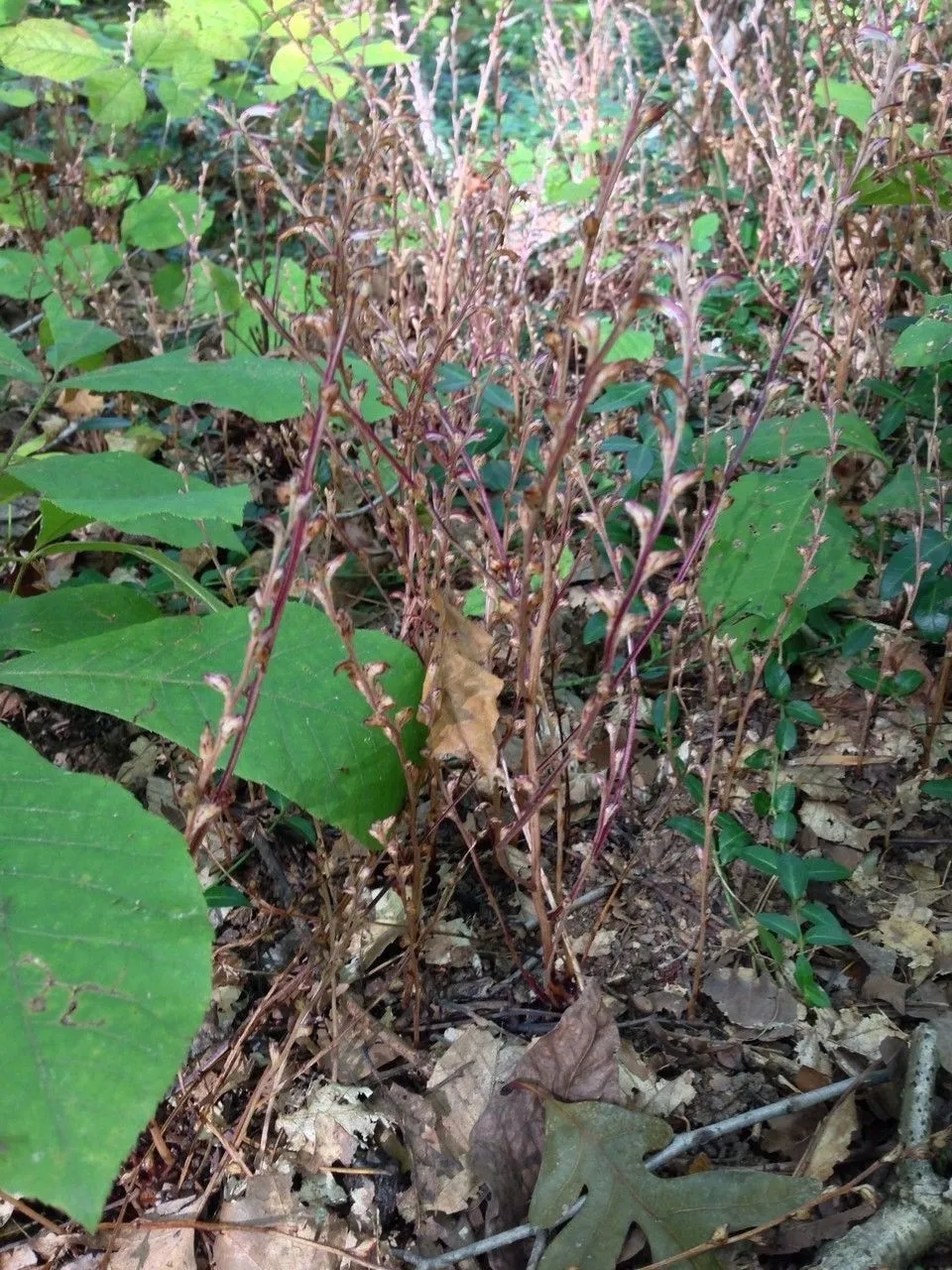
Author: (L.) Barton
Bibliography: Comp. Fl. Philadelph. 2: 50 (1818)
Year: 1818
Status: accepted
Rank: species
Genus: Epifagus
Vegetable: False
Observations: E. Canada to C. & E. U.S.A. and Mexico (Tamaulipas, Hidalgo)
Beechdrops, scientifically known as Epifagus virginiana, are a fascinating and unique plant species belonging to the Orobanchaceae family. These unusual plants are native to eastern Canada, central and eastern United States, and even extend as far south as Tamaulipas and Hidalgo in Mexico. First detailed in “Compendium Florae Philadelphicae” in 1818 by Barton, Beechdrops present a beautiful example of botanical adaptation and specialization.
Beechdrops are parasitic plants, primarily found beneath beech trees (Fagus grandifolia), from which they derive their nutrients. Unlike most plants, Beechdrops do not host chlorophyll and, thus, lack the green coloring typical of photosynthetic organisms. Instead, they are distinctly brownish or purplish in hue, blending into the forest floor where they can be somewhat elusive to spot.
Their lifecycle is finely tuned with that of their host trees. Beechdrops have specialized root structures called haustoria that penetrate the roots of beech trees, tapping into their nutrient supply. As a result, they depend entirely on their host trees for sustenance, an intricate relationship demonstrating nature’s complexity.
Flowering from late summer into fall, Beechdrops produce delicate, tubular flowers. These flowers are small, often with a purplish or white tint, adding a touch of understated elegance to their otherwise modest presence. The flowers are bilaterally symmetrical and produce seeds prolifically. Given their parasitic lifestyle, they have a somewhat limited growth above ground, focusing their efforts instead on their root connections.
In historical botanical literature, Beechdrops have been recorded meticulously for their unique characteristics and adaptations. Barton’s work in the early 19th century brought attention to their special ecological niche, highlighting their role within forest ecosystems. Beechdrops, while not a common sight, play a vital role in the biodiversity of the forests they inhabit.
In summary, Epifagus virginiana or Beechdrops, are intriguing parasitic plants that thrive under the canopy of beech trees. Without the need for photosynthesis, they exemplify a captivating divergence from typical plant behavior, relying on their host trees for survival. Their presence enriches the tapestry of the ecosystems they inhabit, reminding us of the complex interdependencies that define natural habitats.
Eng: beechdrops, virginia beechdrops
Fra: épifage de virginie
En: Beechdrops, Beech Drops, Beech-Drops, Virginia beechdrops
Fr: Épifage de Virginie
Taken Oct 1, 2020 by David Smith (cc-by-sa)
Taken Sep 6, 2022 by Laura Bonet (cc-by-sa)
Taken Sep 27, 2022 by Debbye (cc-by-sa)
Taken Sep 22, 2022 by Goulidan Finch (cc-by-sa)
Taken Oct 6, 2021 by Debbye (cc-by-sa)
Taken Oct 9, 2022 by Martha Gordon (cc-by-sa)
Taken Sep 25, 2021 by Matt Miller (cc-by-sa)
Taken Sep 24, 2022 by Becky He (cc-by-sa)
Taken Jun 28, 2020 by rebecca faeder (cc-by-sa)
Taken Sep 22, 2022 by Emmanuelle Desroches-Jacques (cc-by-sa)
Taken Oct 2, 2013 by EOL − Ann Walter-Fromson (cc-by-nc)
Taken Sep 30, 2013 by EOL − hobiecat (cc-by-nc)
Taken Sep 30, 2013 by EOL − Dan Nydick (cc-by-nc)
Taken Nov 19, 2014 by EOL − Matt Rung (cc-by-nc)
Taken Nov 6, 2014 by EOL − Susan Elliott (cc-by-nc)
Taken Oct 19, 2015 by EOL − Susan Elliott (cc-by-nc)
Taken Dec 26, 2014 by EOL − Charlie Hohn (cc-by-nc)
Taken Sep 7, 2013 by EOL − Susan Elliott (cc-by-nc)
Taken Oct 5, 2013 by EOL − Dan Nydick (cc-by-nc)
Taken Nov 2, 2014 by EOL − Charlie Hohn (cc-by-nc)
Taken Mar 24, 2015 by EOL − jenngribben (cc-by-nc)
Taken Jan 1, 1900 by EOL − Dorr, L.J. (cc-by-nc-sa)
Taken Jan 1, 1900 by EOL − Niehaus, T.F. (cc-by-nc-sa)
Taken Sep 19, 2013 by EOL − Robert L Curtis (cc-by-nc-sa)
Taken Sep 30, 2013 by EOL − Dan Nydick (cc-by-nc)
© copyright of the Board of Trustees of the Royal Botanic Gardens, Kew.
Growth habit: Forb/herb
Family: Myrtaceae Author: (F.Muell.) K.D.Hill & L.A.S.Johnson Bibliography: Telopea 6: 402 (1995) Year: 1995 Status:…
Family: Rubiaceae Author: Pierre ex A.Froehner Bibliography: Notizbl. Bot. Gart. Berlin-Dahlem 1: 237 (1897) Year:…
Family: Sapindaceae Author: Koidz. Bibliography: J. Coll. Sci. Imp. Univ. Tokyo 32(1): 38 (1911) Year:…
Family: Asteraceae Author: A.Gray Bibliography: Pacif. Railr. Rep.: 107 (1857) Year: 1857 Status: accepted Rank:…
Family: Fabaceae Author: Medik. Bibliography: Vorles. Churpfälz. Phys.-Ökon. Ges. 2: 398 (1787) Year: 1787 Status:…
Family: Aspleniaceae Author: (Cav.) Alston Bibliography: Bull. Misc. Inform. Kew 1932: 309 (1932) Year: 1932…